#Shai Halevi
Explore tagged Tumblr posts
Text
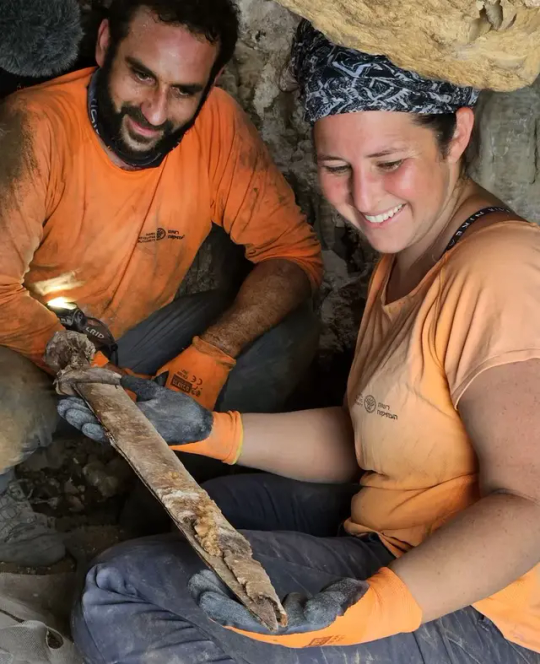
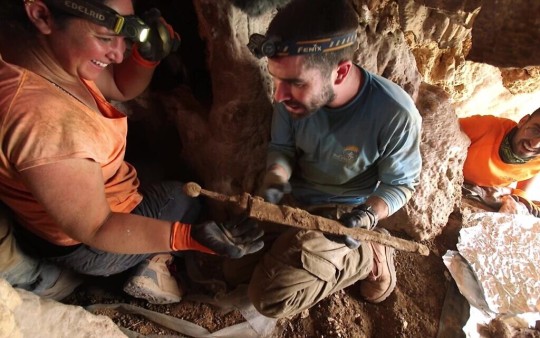
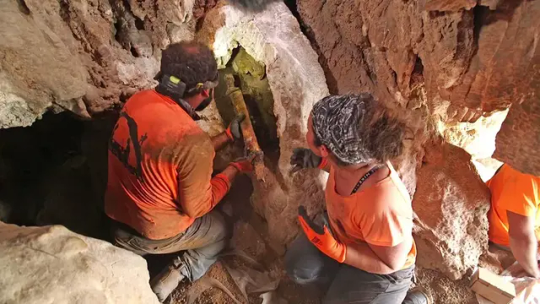
Four 1,900-Year-Old Roman Swords Found in a Judean Desert Cave
Apparently stolen by Jewish rebels, the incredibly well-preserved weapons are ‘an extremely rare find, the likes of which have never been found in Israel’
Archaeologists have discovered four 1,900-year-old Roman swords in a cave in the Judean Desert, which experts believe were captured by the Judean rebels during the Bar Kochba revolt and placed in a narrow crevice in the rock.
“We’re talking about an extremely rare find, the likes of which have never been found in Israel,” Dr. Eitan Klein, one of the directors of the Israel Antiquities Authority’s Judean Desert Survey, said in a video accompanying the announcement of the discovery. “Four swords amazingly preserved, including the fine condition of the metal, the handles, and the scabbards.”
The preliminary article on the swords is published in the volume “New Studies in the Archaeology of the Judean Desert: Collected Papers,” which explores new archaeological finds discovered in the Judean Desert Survey Project. A conference launching the book is taking place Wednesday in Jerusalem.
The four swords were discovered shoved into a small fissure in a cave near Ein Gedi National Park, near the Dead Sea. The cave is already well-known to archaeologists, as it contains a stalactite with a fragmentary ink inscription written in ancient Hebrew script characteristic of the First Temple period.
Recently, Dr. Asaf Gayer of Ariel University, geologist Boaz Langford of Hebrew University, and Israel Antiquities Authority photographer Shai Halevi returned to the cave to photograph the stalactite with multispectral photography, which can decipher additional parts of the inscription not visible to the naked eye. While inside the cave, Gayer spotted an extremely well-preserved Roman pilum — a shafted weapon — in a deep, narrow crack in the rock. He also found pieces of carved wood in an adjacent niche that turned out to be parts of the swords’ scabbards.
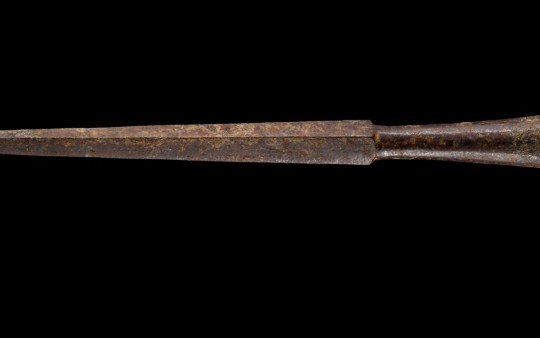
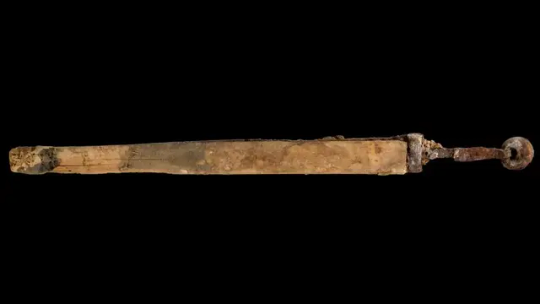

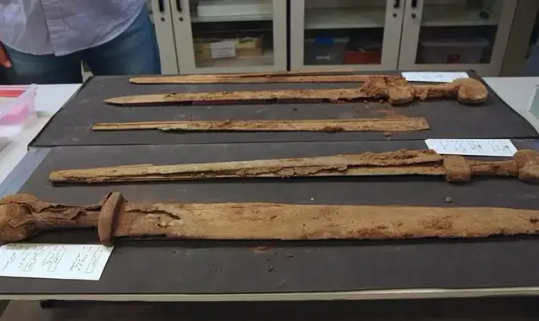
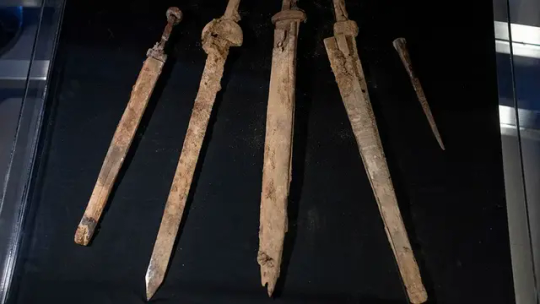
The researchers reported the find to the Israel Antiquities Authority and returned to the site with the Judean Desert Archaeological Survey Team, which is conducting a multi-year comprehensive survey of more than 800 caves in the Judean Desert to find and preserve archaeological remains before they are looted.
It was then that they discovered the four swords, three of which were found with the blades still inside their scabbards. Researchers also found ornate handles made of wood and metal with leather strips nearby. The arid climate in the Judean Desert helps preserve fragile artifacts that might otherwise be lost to the ravages of time, including materials such as leather and wood, which are rarely found in wetter parts of the country.
Three of the swords are Roman spatha swords, with blades 60 to 65 centimeters (23.5 to 25.5 inches) long. The fourth weapon, a ring-pommel sword, is shorter, with a 45-centimeter (18-inch) blade. The swords likely belonged to Roman soldiers and were stolen by Judean rebels who hid them in a cave either for later use or to avoid being caught with them.
“The blades have been preserved so well, they look like they could be picked up and used right now, even 2,000 years after they were forged,” said Langford. “You just realize that you are touching history, because here you are touching a find whose story you know.”
The Bar Kochba revolt, from 132 to 135 CE, also called the Second Jewish Revolt, was a Jewish rebellion against Roman rule in Judea led by rebel leader Simon Bar Kochba. Archaeologists believe the swords were likely hidden in the crevices inside the cave sometime during the revolt, as it was dangerous for Jews to be found with Roman weapons.
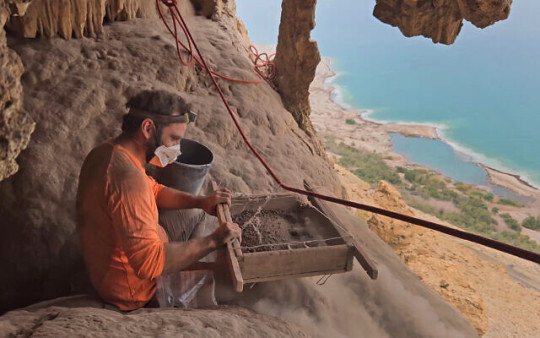
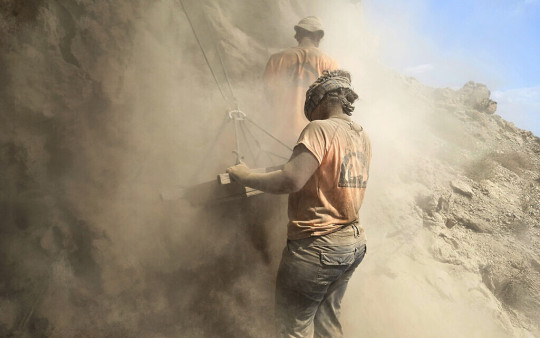
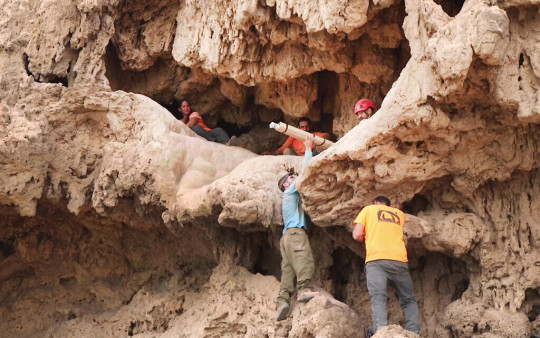
“This is a very rare and unique find on an international level that will shed light on the last moments of the war between the Jewish rebels and the Roman army at the time of the Bar Kochba revolt,” said Klein.
‘A unique time capsule’
The cave survey is being undertaken by the IAA in cooperation with the Archaeology Department of the Civil Administration in Judea and Samaria, and has been funded in part by the Ministry of Jerusalem Affairs and Heritage. Each body allocated about a third of the project budget.
Earlier this year, archaeologists carrying out the Judean Desert cave surveys discovered a rare half-shekel coin minted by the Bar Kochba underground economy.
The cave survey started in 2017 and helped archaeologists discover at least 20 new caves they had not previously known. In 2021, archaeologists announced that one of the caves contained previously undiscovered fragments of the Dead Sea Scrolls, some 60 years after the last pieces of the Dead Sea Scrolls were discovered.

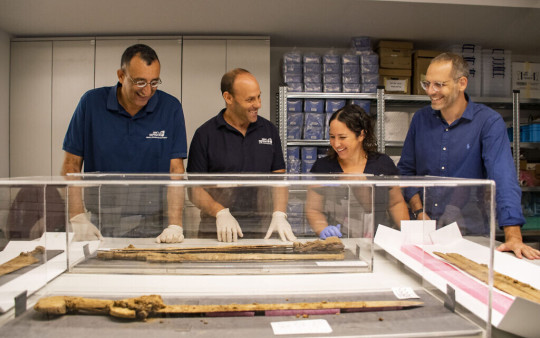
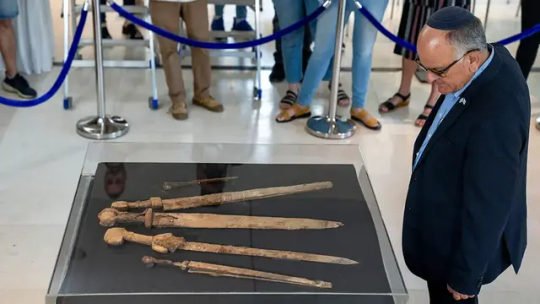
Following the discovery of the swords, archaeologists carried out an extensive excavation of the cave, discovering artifacts from the Chalcolithic period (around 6,000 years ago) and the Roman period (around 2,000 years ago). At the entrance to the cave, researchers found a Bar Kochba bronze coin from the time of the revolt that could help pinpoint the dates when the weapons were hidden.
“This is a dramatic and exciting discovery, touching on a specific moment in time,” said Eli Escusido, director of the Israel Antiquities Authority.
Noting that not all are aware that the dry climatic conditions in the Judean Desert enable the preservation of artifacts that do not survive in other parts of the country, Escusido called the area a “unique time capsule” where it is possible to find “fragments of scrolls, coins from the Jewish Revolt, leather sandals — and now even swords in their scabbards, sharp as if they had only just been hidden away today.”
By Melanie Lidman.
#Four 1900-Year-Old Roman Swords Found in a Judean Desert Cave#Ein Gedi National Park#Judean Desert Survey#Dead Sea#Bar Kochba revolt#roman swords#roman weapons#ancient artifacts#archeology#archeolgst#history#history news#ancient history#ancient culture#ancient civilizations#roman history#roman empire#ancient Israel#Israel history#long reads
359 notes
·
View notes
Photo
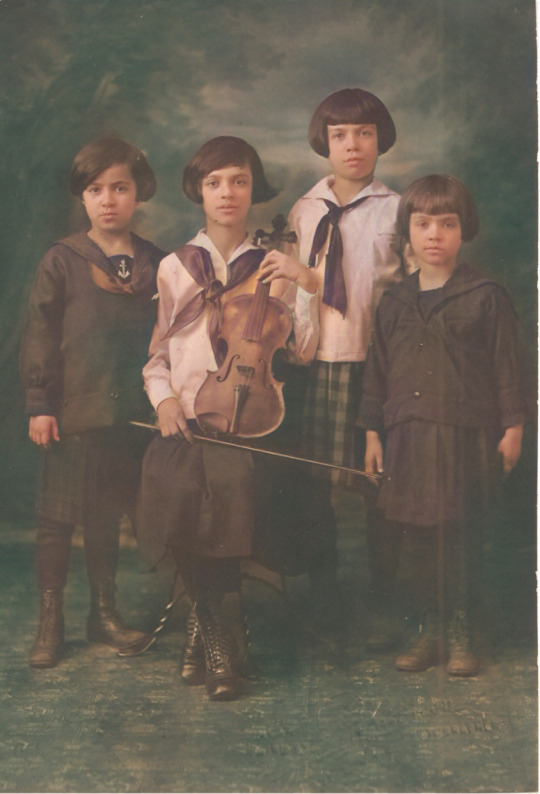
From shai-akivah-bat-daniel-halevi@tumblr: 1923 picture of her great grandmother Olga (left) with her sisters Edna, Freda and Mali (short for Malkah),
60 notes
·
View notes
Text
Emblem of King George V Discovered in Jerusalem
“The symbols were uncovered during research conducted by Shai Halevi and Michael Tchernin of the Israel Antiquities Authority, who mapped and deciphered forgotten British symbols at the site,” Ynetnews reports. From the time when Britain occupied Israel and Arab pretend that the land was ruled by them. http://aqurette.blog/T86GsG
0 notes
Text
“The toilet museum should sell cereal”
- @shai-bat-daniel-halevi
1 note
·
View note
Text
GRAFFITI DI PELLEGRINI MEDIEVALI SCOPERTI SUL MONTE SION, GERUSALEMME
GRAFFITI DI PELLEGRINI MEDIEVALI SCOPERTI SUL MONTE SION, GERUSALEMME
Cinque secoli dopo il pellegrinaggio di Adrian von Bubenberg in Terra Santa, nel 1466 per precisione, un progetto di ricerca di Michael Chernin e Shai Halevi dell’Israel Antiquities Authority, che documenta graffiti e iscrizioni dei pellegrini, ha identificato il nome e lo stemma di famiglia del nobile eroe svizzero su una parete nel Complesso della Tomba del re David, sul Monte Sion, a…

View On WordPress
#Adrian von Bubenberg#Gerusalemme#Hebrew University#Michael Chernin#Monte Sion#Shai Halevi#Tomba di Davide#Università di Tel Aviv
0 notes
Link
A rare collection of several dozen adorned architectural stone artifacts, dated to the First Temple period, which together were part of a magnificent structure, was discovered in the Israel Antiquities Authority’s excavations in the Armon Hanatziv Promenade, where past British governors of the Land of Israel resided until 1948. The dig was conducted head of the establishment of a visitor center on the promenade.

These stone artifacts are made of soft limestone, with decorative carvings, and among them are capitals of various sizes in the architectural style known as Proto-Aeolian, one of the most significant royal palace features of the First Temple period.
The unveiled collection includes three complete medium-size stone capitals and items from lavish window frames, incorporating balustrades composed of stylish columns on which a series of Proto-Aeolian style tiny capitals were affixed.

The uncovering of the capitals. / Shai Halevi, Israel Antiquities Authority
According to Yaakov Billig, Director of the IAA excavation, “this is a very exciting discovery. It’s a first-time discovery of scaled-down models of the giant Proto-Aeolian capitals, of the kind found thus far in the Kingdoms of Judah and Israel, where they were incorporated above the royal palace gates. The level of workmanship on these capitals is the best seen to date, and the degree of preservation of the items is rare.”
Two of the three column capitals were found buried neatly, one on top of the other. “At this point it is still difficult to say who hid the capitals in the way they were discovered, and why he did so, but there is no doubt that this is one of the mysteries at this unique site, to which we will try to offer a solution,” Billig said.

Unlike the capitals, which were discovered preserved in excellent condition, the rest of the building was destroyed, probably in the Babylonian destruction of Jerusalem in 586 BCE or thereabout. The remains of the building were demolished and dismantled for secondary use.
Billig believes the magnificent structure—built in the period between King Hezekiah and King Josiah—indicates the restoration of Jerusalem after the Assyrian siege of the city in 701 BCE, during the reign of King Hezekiah – a siege which the city barely survived.
“This discovery, along with the palace previously uncovered in Ramat Rachel and the administrative center recently uncovered by the IAA on the slopes of Arnona, attests to a new revival in the city and the partial settlement beyond the city walls after the Assyrian siege. We excavated villas, mansions and government buildings in the area outside the walls of the city. This testifies to the relief felt by the city’s residents and the recovery of Jerusalem’s development after the Assyrian threat was over,” Billig proposes.

The excavations were funded by the Ministry of Tourism, the Jerusalem Municipality and the Ir David Foundation (Elad).
The findings were unveiled to the public on Thursday in a festive event in the City of David’s Jerusalem Walls National Park, which was attended by Culture Minister Hili Tropper, Chief Archaeologist for the IAA’s Jerusalem region, Dr. Yuval Baruch, and Chairman of the Ir David Foundation, David Be’eri.
The findings will be on display in an exhibition at the City of David over the next few days, and an account of their significance will be given online at the Megalim Conference, to be held this coming Tuesday on the City of David website.
youtube
31 notes
·
View notes
Photo



Dig this! A seal and seal impression discovered in the City of David sheds light on what life may have been like during the restoration of Jerusalem in the 6th Century BCE. Shai Halevy, IAA and Eliyahu Yanai, City of David Ancient Jerusalem
6th Century seals found in City of David shed light on Jerusalem life during Persian period
A seal and seal impression on a bulla uncovered at the City of David has shed light on what life may have been like during the restoration of Jerusalem in the 6th Century BCE.
The 2,500-year-old artifacts are believed to date back to the time of biblical figures Ezra and Nechemiah who lived during the Persian period.
According to the archaeologists, the double stamp impression on a bulla and a seal made of reused pottery were found during archaeological excavations in the Givati Parking Lot Excavation of the City of David, in the Jerusalem Walls National Park being conducted by the Israel Antiquities Authority (IAA) and Tel Aviv University.
The IAA added that they were discovered next to the rubble of a large structure that was destroyed during the Babylonian destruction of Jerusalem.
Explaining the significance of the find, TAU Prof. Yuval Gadot of the Archaeology and Ancient Near Eastern Cultures department, and the IAA’s Dr. Yiftah Shalev said that despite numerous excavations conducted in Jerusalem to date, “so far the findings revealed from the Persian period are extremely meager and therefore we lack information regarding the character and appearance of the city during this period.”
youtube
More: Here
31 notes
·
View notes
Text
Archaeologists Devise a Better Clock for Biblical Times
https://sciencespies.com/news/archaeologists-devise-a-better-clock-for-biblical-times/
Archaeologists Devise a Better Clock for Biblical Times

A new approach to studying the history of Old Testament conflicts, courtesy of Earth’s geomagnetic record.
When it comes to assigning dates to military campaigns described in the Bible, the parameters of the debate take on almost biblical proportions. Exactly when did the Amalekites wage war against the Hebrews in the wilderness? Did Joshua fight the Battle of Jericho in 1500 B.C. or in 1400 B.C. — or at all?
Such uncertainty exists, in part, because the radiocarbon analysis that scientists use to date organic remains is less accurate for certain epochs. And, in part, because archaeologists often disagree over what the timelines for different narratives should be. But a new technique, which makes use of consistently reliable geomagnetic data, allows scientists to study the history of the Levant with greater confidence.
Many materials, including rocks and soils, record the reversals and variations over time in earth’s invisible geomagnetic field. When ancient ceramics or mud bricks that contain ferromagnetic, or certain iron-bearing, minerals are heated to sufficiently high temperatures, the magnetic moments of the minerals behave like a compass needle, reflecting the orientation and intensity of the field at the time of burning. The new methodology can provide a sort of geobiblical clock.
“Based on the similarity or difference in the recorded magnetic signals, we can either corroborate or disprove hypotheses” about when certain layers of sediment might have been destroyed during biblical battles, said Yoav Vaknin, a doctoral candidate at Tel Aviv University and the Hebrew University at Jerusalem, who pioneered the technology. “It all fits together perfectly, better than I had ever imagined.”
Yoav Vaknin, a doctoral candidate at Tel Aviv University and the Hebrew University at Jerusalem, takes measurements of a floor that collapsed during the Babylonian siege of Jerusalem in 586 B.C. Shai Halevi/Israel Antiquities Authority
Mr. Vaknin’s research, published this year in the Proceedings of the National Academy of Sciences, harnesses information from 20 international scholars to map out a geomagnetic data set of 21 layers of historical destruction across 17 sites in the Holy Land.
The project is an attempt to check the historical authenticity of Old Testament accounts of the Egyptian, Aramaean, Assyrian and Babylonian offensives against the Kingdoms of Israel and Judah, and conflicts between these two realms. For those readers without a scorecard, the principals included Shoshenq I (1 Kings 14: 25-26), Hazael (2 Kings 12:18), Jehoash (2 Kings 14:11-15), Tiglath-pileser III (2 Kings 15:29), Sennacherib (2 Kings 18-19) and Nebuchadnezzar (2 Kings 25:1-21).
“With this new data set, we can narrow things down to a decadal level,” said Thomas Levy, an archaeologist at the University of California, San Diego, who was not involved with the study. “That is super important when trying to connect ancient historical events to the archaeological record.”
The real significance of the research is in the interdisciplinary connections, said Oded Lipschits, an archaeologist and one of the study’s co-authors: Experts in the new technique, known as archaeomagnetism, gain “chronological anchors” from the work of archaeologists — footholds in the historical timeline. “And in return, archaeology gets a new tool for dating, whose main application is in the first millennium B.C., a period when radiocarbon is less effective and impossible to rely on.”
The study stands apart not only for its content, but also for its researchers. All but one of the study’s authors are archaeologists — many of them with contradictory views on biblical history and the chronology of the period.
Rather than provide absolute dates, Mr. Vaknin’s database compares magnetic readings of burned materials at various sites. Where historical evidence has already established precise timelines, nearby sites can also be dated.
To understand the mysterious mechanism of earth’s magnetic field, geophysicists track its changes throughout history by using archaeological relics — furnaces, ceramic shards and roof tiles — that contain ferromagnetic minerals.
In a 2020 paper, Mr. Vaknin and his colleagues used floor fragments and smashed pottery from a large, two-story building excavated in a Jerusalem parking lot to recreate Earth’s magnetic field, as it was on the ninth of the Hebrew month of Av, 586 B.C., which is recognized as the date when Nebuchadnezzar and his Babylonian army annihilated the First Temple and the city of Jerusalem.
The more recent study reconstructed the magnetic field recorded in burned remains at biblical sites in present-day Israel that were razed by fire. Using archaeomagnetic readings that have been preserved for millenniums in mud bricks, in a mud beehive and in two collections of ceramic objects and historical information from ancient inscriptions, the team analyzed layers of ruin left behind by military conflicts.
The findings help settle a longstanding debate over how exactly the Kingdom of Judah fell and disproves claims that the ancient settlement of Tel Beit She’an, a magnet for conflagrations and epic sieges, was razed in the ninth century B.C. by the Aramaean armies of Hazael of Damascus. Magnetic dating indicates instead that Beit She’an was burned to the ground some 70 to 100 years earlier; this links the destruction to the Egyptian pharaoh Shoshenq, whose campaign was described in the Hebrew Bible and in an inscription on a wall of the Temple of Amun in Karnak, Egypt, which mentions Beit She’an as one of the king’s conquests.
A burned mud-brick wall from the site of Tel Batash, or biblical Timnah, with markings indicating the orientation of Earth’s magnetic field at the time of the site’s destruction.Yoav Vaknin
Curiously, other data indicate that, about a century later, Hazael’s soldiers set fire to several settlements: Tel Rehov, Tel Zayit and Horvat Tevet, in addition to Gath, one of the five royal cities of the Philistines (and home to Goliath), whose destruction is noted in 2 Kings 12:17. The study, which examined the geomagnetic records at all four sites at the time of demolition, strongly suggests that they were burned during the same military offensive, according to the researchers.
Mr. Vaknin spent four years pioneering the application of paleomagnetic research to biblical archaeology, aided by his doctoral advisers, Dr. Lipschits, Erez Ben-Yosef of Tel Aviv University and Ron Shaar of the Institute of Earth Sciences at the Hebrew University of Jerusalem.
Besides helping to date archaeological contexts, the technology provides invaluable information on Earth’s magnetic field, one of the most enigmatic phenomena in geoscience. “Since instrumental recording of the field started about 200 years ago, the field’s strength has declined, and there is a danger that we might lose it completely,” Dr. Ben-Yosef said. “Understanding this trend and how dangerous it is requires data on the past behavior of the field.”
Earth’s magnetosphere is a protective bubble that deflects solar winds, streams of charged particles from the sun that gust through the solar system, and cosmic rays from deep space. Scientists theorize that the magnetic field is generated by a layer of molten iron and nickel in the planet’s outer core, about 1,800 miles below the surface, that is in continual flux around a solid iron core. As ferromagnetic particles in ancient artifacts cool, their magnetic moments are baked into the alignment. So long as the objects don’t heat up again, they will retain what is effectively a fossilized magnetic field. Each reheating beyond a certain temperature wipes out all previously recorded magnetic signals, so that the date is always of the most recent firing.
From around 800 to 400 B.C., as a result of changes in the percentage of radiocarbon in the atmosphere, the resolution of radiocarbon dating during those years is so limited that archaeologists seldom use it.
Dr. Ben-Yosef said he hoped that the new dating method would finally settle questions about the fall of the Kingdom of Judah. While it is widely accepted that the Babylonians laid waste to the Judean polity in 586 B.C., some researchers, relying on historical and archaeological evidence, argue that the invaders were not solely responsible. The intensity of the magnetic field as recorded in the destruction layer of the site of Malhata — a city on the southern periphery of Judah — is different and significantly lower than the one recorded in the Babylonian destruction of Jerusalem, the capital of the kingdom.” This means that the two destructions cannot be related to the same event,” Dr. Ben-Yosef said.
The archaeomagnetic data provided clear evidence that Malhata was destroyed decades later, a scenario that fits the notion that the Edomites, Judah’s southern neighbors, took advantage of the weakness of the Judahites after the Babylonian attack, decimated their southern cities and raided their territory.
“These events are reflected in the Hebrew Bible,” Dr. Ben-Yosef said. “They explain the animosity toward the Edomites by several prophets, notably Obadiah.”
Scholars who had partly absolved the Babylonians should feel vindicated, he added. “Now, the magnetic results support their hypothesis. The big deal about this research is that after decades of work on establishing a reference database, we finally reap the fruits of our labor, and what we saw has become a potent dating tool in biblical archaeology that, undoubtedly, will become part of the tool kit of archaeologists working in the Holy Land.”
#News
1 note
·
View note
Text
@shai-bat-daniel-halevi 👀
what if . . . we looked at the light of the Havdalah candle through each other's fingernails . . .
and we're both boys 😳😳😳
112 notes
·
View notes
Text
Fragmentos de manuscritos descubiertos en Judea lanzan luz sobre la Biblia.
Fragmentos de manuscritos descubiertos en Judea lanzan luz sobre la Biblia.
Secciones del pergamino del Libro de los Doce Profetas Menores descubiertos en la expedición al Desierto de Judea antes de su conservación. (Foto: SHAI HALEVI / ISRAEL ANTIQUITIES AUTHORITY) Este martes 16 se reveló la ubicación de fragmentos de un pergamino bíblico con fecha de, por lo menos, hace dos mil años. El anuncio oficial de los hallazgos fue de la Autoridad de Antigüedades (IAA), de…

View On WordPress
0 notes
Text
Arqueólogos de Israel encontram fragmentos de textos da Bíblia em caverna no deserto da Judeia
Arqueólogos de Israel encontram fragmentos de textos da Bíblia em caverna no deserto da Judeia
Arqueólogos de Israel encontram fragmentos de textos manuscritos da bíblia – Foto: Shai Halevi/Israel Antiquities Authority Arqueólogos de Israel encontraram, no deserto da Judéia, dezenas de fragmentos de pergaminhos com textos manuscritos da Bíblia. A informação foi divulgada pelo governo israelense nesta terça-feira (16/03). Depois de usar drones para mapear centenas de buracos, arqueólogos…

View On WordPress
0 notes
Text
Dead Sea Scrolls and the Cave of Horror
Dead Sea Scrolls and the Cave of Horror
Shai Halevi, IAA March 2021, Israel Antiquities Authority (IAA): It has been 60 years since there have been archaeological finds of the Dead Sea Scrolls. Research in the Judean Desert has unearthed Greek translations of the Bible prophets Nahum and Zechariah. The scroll was found in the “Cave of Horror”. The cave got its name when discovered in the 1950’s. There were skeletons from over 40…

View On WordPress
#Archaeologists#archaeology#Bar Kochba revolt#Cave of Horror#Dead Sea Scrolls#God#Israel Antiquities Authority#Judean Desert#Nahum 1#prophets#Zechariah 8
0 notes
Text
2,000 year old Bible fragments found (great) with a 10,000 year old basket (bad)
2,000 year old Bible fragments found (great) with a 10,000 year old basket (bad)
photo credit: SHAI HALEVI / ISRAEL ANTIQUITIES AUTHORITY Archaeologists have found some fragments of OT prophets written in Greek which they dated back 2,000 years. In the same location a 6,000 year old skeleton was found (a young child carefully buried in their blanket) and a 10,000 year old basket. Guess which date is accepted cheerfully by literalists and which two are rejected as a…
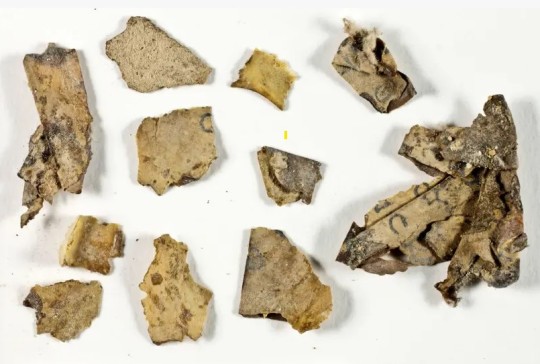
View On WordPress
0 notes
Text
Archeologists Discover More Dead Sea Scroll Fragments : NPR
Archeologists Discover More Dead Sea Scroll Fragments : NPR
Part of the Twelve Minor Prophets scroll, written in Greek. Shai Halevi/Israel Antiquities Authority hide caption toggle caption Shai Halevi/Israel Antiquities Authority Part of the Twelve Minor Prophets scroll, written in Greek. Shai Halevi/Israel Antiquities Authority JERUSALEM – Israeli government archaeologists say they have discovered tiny fragments of an ancient biblical scroll near…

View On WordPress
0 notes
Text
Relationship status: single :(
Favourite colour: pink 💗
Song stuck in my head: Punchline by King Mala
Three favourite foods: mac n cheese, custard tarts, Greek salad
Last song I listened to: Love From The Other Side by Fall Out Boy
Dream trip: so many places but I really really want to go back to Amsterdam so I'll say that
Last thing I googled: art references of woman lying down
@mostlybats-partiallyrats @shai-akivah-bat-daniel-halevi @translesbianorchestra or anyone else
I guess I'm doing this now?
Tagged by: @heartsick-honeybee
Rules: Tag 10 (or less) people you want to get to know better
Relationship Status: Single
Favorite Color: Ocean Blue-Green
Song Stuck in My Head: Heaven, Iowa - Fall Out Boy
Three Favorite Foods: Potato Soup, Pickles, Mustard (I know it’s a condiment but I fuckin love mustard, dude)
Last Song I Listened To: It’s Gonna Be Me - *NSYNC
Dream Trip: Iceland, I think. It looks breathtaking
Last Thing(s) I Googled: Kite Jellyfish/Fish that looks like a kite/Enormous female fish (it's been bugging me for days. there's some kind of fucking fish, bro. if anyone knows what I'm talking about, please help me. it's an enormous fish/jellyfish[?] and the females are fucking huge but the males are nearly microscopic and they die as soon as they fertilize the female egg. I know a little sciencey tmi, but if you know PLEASE tell me)
@rallazarthemagnificent @animathemutant @r1ddly @sigma-time-lord @finniestoncrane @seasoned-stingray @hallowsden
Also, no worries if you’re not interested in participating. You’re not gonna hurt my feelings, promise.
101 notes
·
View notes
Text
Architectural Artifacts from First Temple Period Found
Architectural Artifacts from First Temple Period Found
Rare architectural details of Proto-Aeolic style discovered on the Armon Hanatziv Promenade
Jonathan Laden September 07, 2020 BIBLICAL ARCHAEOLOGY SOCIETY

Proto-Aeolic baluster columns of an ancient window. <em>Photo: Shai Halevi, IAA</em>
Dozens of architectural limestone remains were found in excavations of the Armon Hanatziv Promenade. Some of these are Proto-Aeoliccapitals, a…
View On WordPress
0 notes